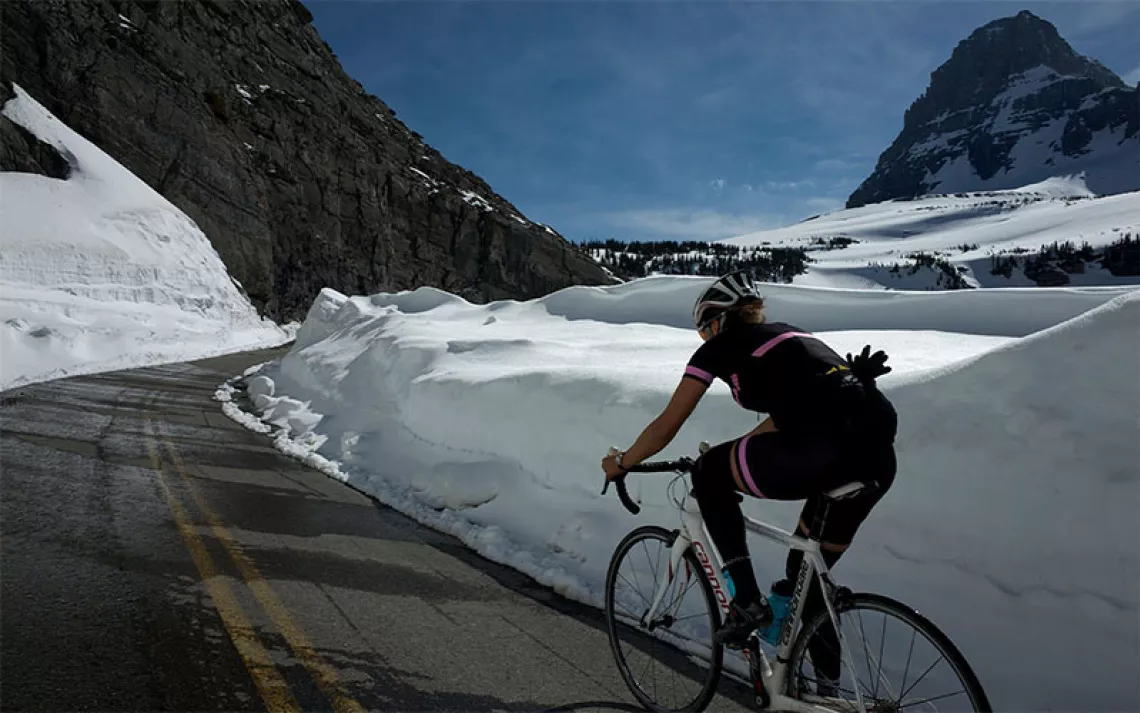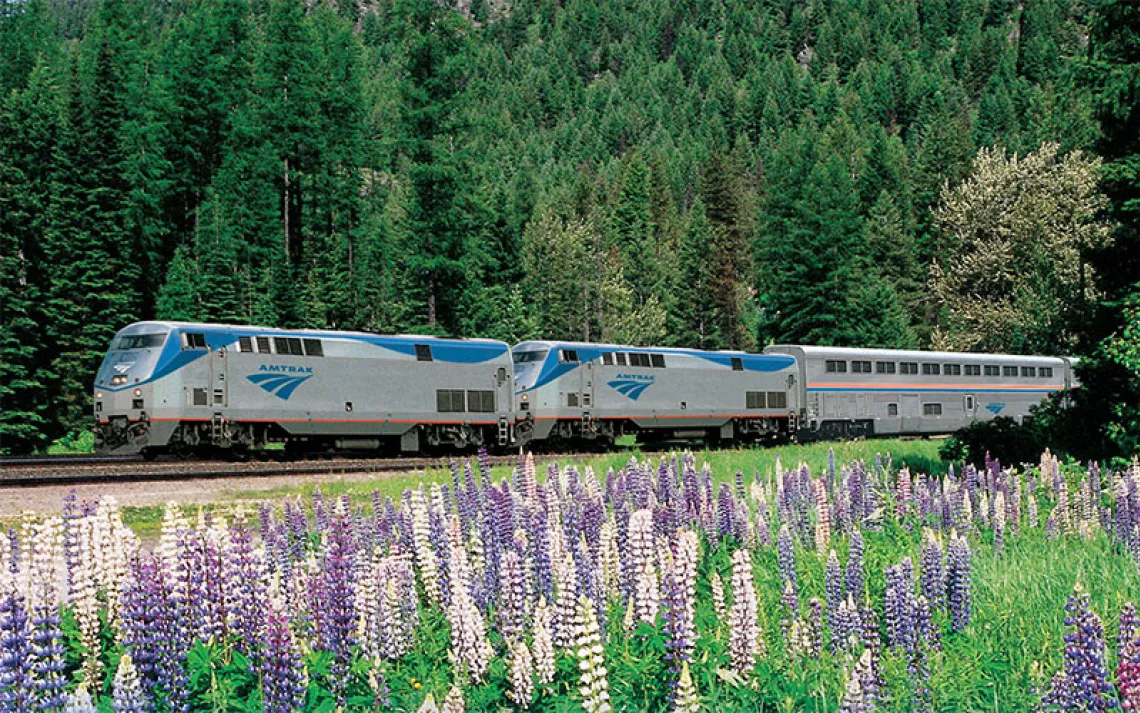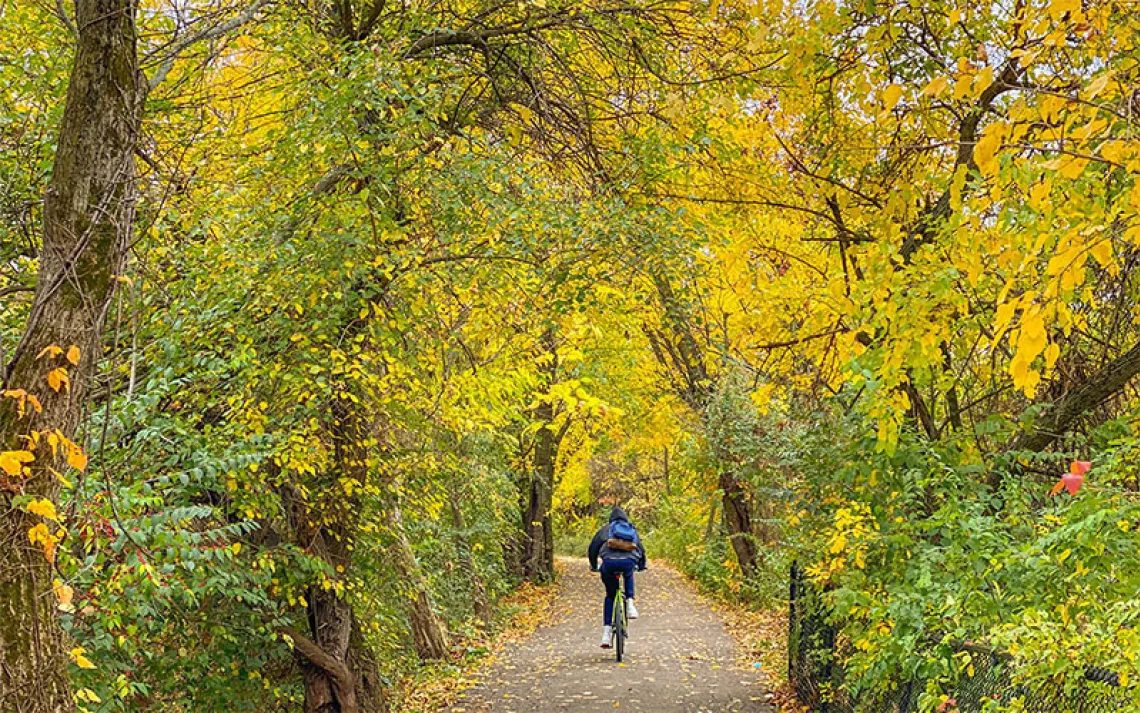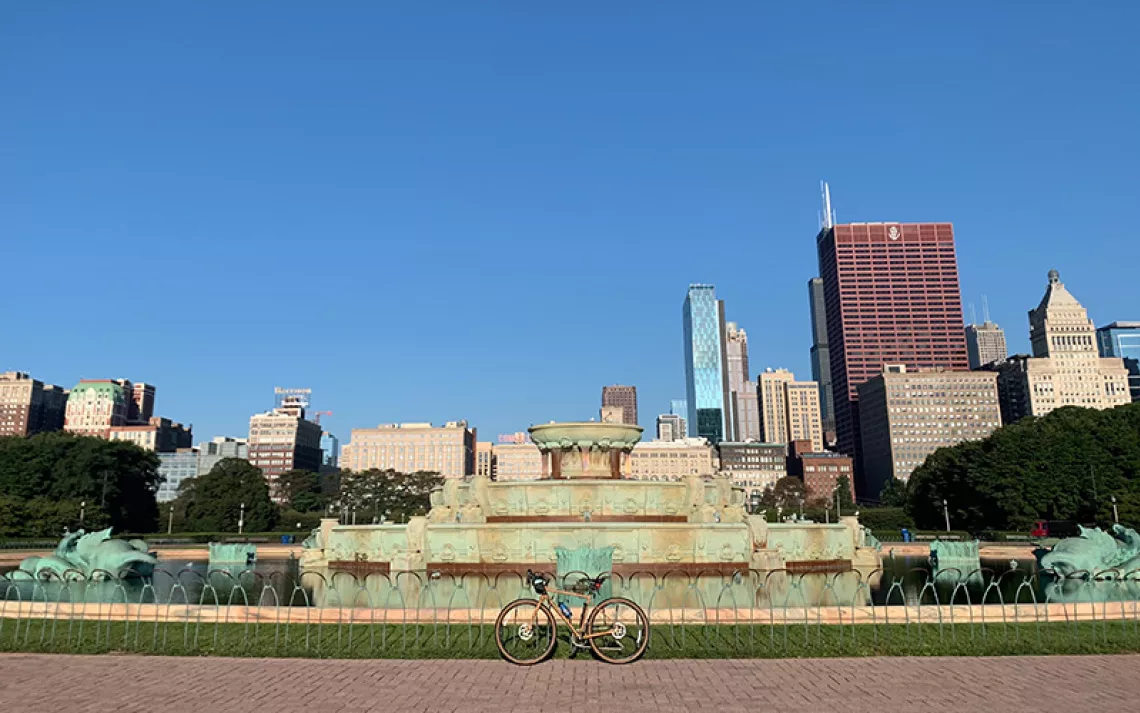Lost in Time
When exploring southeast Alaska in midsummer, you can pedal your fat tire bike on the broad, bear-tracked beaches at midnight and think you have no need for a watch. Oh, but you do.
One evening in mid-June in the remote fishing port of Yakutat, Alaska, a young Tlingit girl and her mother walk past two men hunching over strange bicycles and a spread of colorful equipment outside the town's single-gate airport. "Where are they going on those bikes?" she asks her mother, which is an excellent question considering that Yakutat has only a few short Jeep tracks and no roads or trails leading to another town (because there is no other town).
"I have no idea, honey," her mother replies.
From the patio of a nearby shack, aspirationally named the Yakutat Lodge, a woman in a Bud Light sweatshirt takes out a cigarette and says, "What're you guys doin'?" Ryan Krueger and I point to the fat, four-inch-wide tires on our bicycles and explain that we can ride on sand, that our tiny rafts will allow us to cross the many rivers we will encounter, and that once we figure out how to actually affix our tents and sleeping bags to our bikes and stuff five days of provisions into our backpacks, we intend to ride to the ocean and down its uninhabited coast to see what there is to see.
She considers our dry bags, paddle shafts, bulging bike wheels, and various sacks of food."
"You ever done this before?" she asks dubiously."
"Actually," I say, pausing in my third attempt to strap a deflated raft to my handlebars, "this is our first time."
She says she'll pray for us.
Two young men stumble out of the bar and charge at us: "Wow, those are cool bikes! Where are you guys going? You know there's a load of bears down there? You have guns, right?"
Yes, we say, we know there are bears, and no, we don't have guns. As we finish cinching down our gear, one of the men helpfully calls out, "You guys are up a creek without a paddle!".
"No," I yell back. "We've got paddles."
It's 8 p.m. when we finally set out. Or maybe it's 9--hard to tell with the long summer sun. After a mile or so of pedaling, we emerge from the forest at the cool, gray sea. We whoop, point the bikes down a bank of loose sand, and steer toward the water's edge, where the sand firms up and our bulbous tires speed across its smooth surface.
We're exuberant--this looks like it's going to be easy. Which is good, because I had promised Ryan, a fellow cycling enthusiast, a relaxed ride. Our plan is to head down the coast for three days, then turn around and trundle back. Simple. We were even able to borrow gear from my Alaskan friends, part of a small crew who've been exploring coastlines on "fatbikes" since they became available a decade ago. One of them called this area the best beach riding in the state.
The coast south of Yakutat is a landscape of superlatives--a narrow strip of golden sand sliced by rivers from the continent's largest glaciers, wedged between the Pacific and the St. Elias Range, the world's tallest coastal mountains. "Wildest" might be in there too; we're surrounded by four giant, contiguous parks: Alaska's Wrangell-St. Elias and Glacier Bay National Parks, the Yukon's Kluane National Park, and British Columbia's Tatshenshini-Alsek Park. Known to Alaskans as the Lost Coast, it had sounded like the perfect place for us to try this unusual form of wilderness exploration.
At our sand camp that night, a fire warming our skin in the cool salt air, I admit to Ryan--like me, a Minnesotan whose love of wild places had driven him to Montana--that this is only my second trip in a coastal environment. He one-ups me by telling me it's his first. We consider this in silence for a minute and then spend the rest of the night debating whether the rising tide will submerge our tent.
We stay dry enough overnight, but in the morning an onshore wind hits with a fury, and it feels as if our tent were pitched atop a speeding train. Unlike the famed Inside Passage to the south, the Yakutat coast has no network of islands to blunt the weather off the open sea. When we pause for our first water crossing, gusts threaten to blow our inflated boats to the mountains before we can lash our bikes to them. Once we start pedaling again, the wind is partially at our backs, but any advantage is eaten up when we encounter soft sand. Huge tires or no, our burning legs quickly remind us that we're pedaling fully loaded 50-pound bicycles through sand. It occurs to me that I may have misled Ryan about the easiness of this trip.
Cue the grizzly tracks. I grab binoculars and scamper up a tidal dune. I don't see the bear, but the tracks lead into a sandy plain backed by a wall of mountains. It's my first good look at the landscape here, and neither maps nor reading have prepared me for it. To the north rises Mount St. Elias, at 18,008 feet the fourth-highest mountain in North America. In the south, Mt. Fairweather vaults 15,325 feet directly from the sea. So here I am standing on bear tracks between towering mountains and the world's largest ocean, feeling like a speck on an unruly planet.
Pedaling on, we soon learn to hug the firm surfaces of the littoral zone, edging and dodging incoming waves. The wind rushes in our ears, the sun sparkles on the crashing surf, and we chase shadows of arctic terns across the sand--bike touring at its most nautical. At the ominously named Dangerous River, we stop to study the wind-whipped water. I point out a pair of seals and tell Ryan not to worry--there have been only a few deaths by seal-mauling in recent years. The river constricts like an hourglass before opening to the pummeling surf. We want no part of that in our little rafts, and so we decide to cross upriver where the slower-flowing water widens to the size of a small lake.
My nerves tighten as we clamber into the boats, wriggle our legs under the bikes, and push off. The waves lap at the overhanging wheels, and Ryan yells at the seals popping up in front of his boat. Propelled across with the help of the wind, we pull out at the southern shore.
When we look back, the wind raises whitecaps and stings our eyes. Ryan points out that it would be virtually impossible to get back across in such conditions. Which is worth considering, given that before us lie hundreds of miles of uninhabited coast.
Late that night we head into the rolling dunes in search of a campsite. Suddenly we're beset by screeching terns dive-bombing us from a flaming sky. We have to dodge the birds while hunting for firewood; Ryan swears their talons are out.
He collapses in the sand. We're spent and hungry, and I struggle to start a fire in the wind. We've chosen to save weight by forgoing a campstove, but the driftwood is damper than expected. I forget my fatigue and do a victory dance with the diving terns after finally sparking a blaze.
The wind strengthens toward dawn, and I repeatedly wake to pinpricks on my face. Desperate for sleep, I try to ignore the inner-tent sandstorm, but soon sand is swirling in my ears, hair, and mouth. Then the rainfly starts pulling off. Just after Ryan manages to get his contacts in, the stakes pull out and the tent blows over, flipping me on my back.
We crawl out and somehow pack, disaster-style, without everything kiting away. With my back to the blowing sand, I consider our options. We eventually need to turn back into this wind to return to Yakutat. If this is its prevailing direction, how far should we continue? And where can I get some eyedrops?
There is a decisive moment in any quality adventure when you choose to retreat to safety or leap further into the unknown. Ryan and I are here for the same reason: to directly experience this raw, primordial wilderness on its grandest scale. I don't know if he's thinking the same, but there's no discussion. We grab our bikes and pedal down the beach, pushed by the wind farther and farther from the human world.
I pick up an eagle feather and wedge it upright in my handlebar bag, a statement of allegiance to our temporary home. The wind persists, quickly filling in the tracks of wolves and bears and fat tires. In the cool, elongated Alaskan evening, now our favorite time to ride, a fog spreads from the base of Mt. Fairweather, enveloping us in blue mist. The world goes indistinct. A seal watches from the surf, and an eagle glides down the coast just over our heads, almost close enough to touch. We're just animals now, passing in the wild.
I wake the following morning to stillness.
"There's no wind," I mumble to Ryan. "We're stoked."
"There's a bear on the beach," he says.
I'm alert instantly, hunting simultaneously for camera and pepper spray. Neither are necessary--the grizzly runs off as soon as we emerge from the tent. We sit on the saltgrass talking about the bear and listening to the chatter of gulls. Beyond the waves, whales arc their flukes in the diamond-splattered distance. As much as we would love to continue south along this interstitial wilderness, we reluctantly turn and start the journey back to Yakutat, 40 miles north.
I don't know the exact hour when we reach the southern shore of the Dangerous River, just that it's at the darkest point of the night. By now we are completely unmoored from clock time. A band of orange light silhouettes the sawtooth mountains to the east, and the river is like glass. We consider shooting across right then, but the darkness and the cold, damp air make paddling uninviting.
So we hunker down and start a fire. Alaska makes you skilled at waiting, and at this point, after regularly riding until midnight and staying up until 2 a.m., we're not worried about the time. What's late? What's early? What planet is this? Sipping warm tea on the edge of the lagoon in the twilight blues of the Alaskan night, we watch the moon scatter silver across the water and wait for turquoise light to seep above the horizon. The water is calm when we finally put in around 3 a.m.--but in the interest of making every rookie mistake on our bike-rafting checklist, we decide to cross at the narrows just above the surf. The far shore is right there, but as we near it, we're suddenly grabbed by an unseen force.
A swift current drags us toward the thrashing surf, which could flip us in an instant. We paddle with all our strength. Reaching the shore, we leap from the rafts, then lunge and grab them before the current sweeps them away. Chastened again, we pitch our tent behind a windbreak dune and turn in as the east face of Mount St. Elias catches fire with the morning's first rays.
There's no movement in our camp the next day--or the same day, or whatever day it is now--until the sun is high. We stumble out of the tent, the sand warm on our bare feet, to munch granola bars and watch gulls and eagles in the mudflats near the river. We're feeling at home here. Our skin is leathery. Sand is in our water, our sleeping bags, and every bodily crevice. We know what to expect now, how to handle things. Or so we think until we go to refill our drinking water.
We'd gathered water from the Dangerous on the way in, but here it's brackish. Walking half a mile upriver doesn't improve things. Instead we fill up with brown, sediment-filled sludge from a tributary, which is as unpleasant to drink as it sounds.
That afternoon we pull off the beach as a dark storm charges down from the mountains. At the last second we realize it's not rain but actually a wall of wind. It hits us like a solid object, knocking us backward. We dive for a nearby copse of alder and crawl in for refuge. Inside it's a different world, emerald ceilinged and supported by a multitude of curving, lichen-splattered branches. We make a small fire, listen to the birdsong, sip some rum, and speculate about what Alaska is going to throw at us next.
An hour or two later the wind subsides. We emerge from the thicket and have taken 10 steps when Ryan blurts, "There's a bear right there."
We freeze. Eighty feet away is the largest grizzly either of us has ever seen. Brawny and golden, it turns and locks eyes with us for a breathless second. Now it's decision time for the bruin--run at the puny humans or away from them. It takes longer than we would like, but eventually the bear makes up its mind, lets out a deep "harrumph," and trots away.
The next morning, our last of the trip, I awake desperately thirsty. The muddy murk we've been choking down feels like a stone in my gut. After the resurgent wind flips our tent again, we tromp across a spit to the Ahrnklin River, where I emphatically dump my dirty water and eagerly fill up. Seconds later I'm spitting and coughing. Salty! Alaska apparently does not care how thirsty we are.
When the noon flight out of Yakutat passes overhead at the wrong time, I realize that the state's blatant disregard for traditional temporality has sabotaged my watch. This explains why we've so often mistimed the tides and floundered in soft sand. (Ryan, of the cellphone generation, didn't even wear a watch.) Since we're already across the spit, we can avoid another tide-timing test by paddling the Ahrnklin, which gathers a dozen creeks in its short run from the mountains and joins with the Situk before emptying into the sea. As I'm putting in, a passing fisherman boats by, looks at our flimsy rafts and the wind-whipped waves, and yells, "You guys going to make it?"
I give him a thumbs-up, then yell, "Do you know what time it is?" But his back is already turned, and the wind and river drown my voice. We're confident in our bike-laden boats now, and the rough-water paddle is good fun. We take out smoothly just above the surf, our transitions now fast and fluid, and ride the last few miles of wide, lupine-lined beach toward Yakutat. A couple of hikers pass, then a few people on four-wheelers, all staring at us with our weird bikes, weather-tortured skin, dirty clothes, and salty hair and my eagle feather flying like a flag for the wild.
Encountering humans again is jarring; the fisherman was the first person we've seen in five days. I look at the scintillating waves, our constant companions, and it hits me that we won't be living to their rhythm anymore, won't be staring at the forever sky, at wolf tracks in the sand, or at mountains bigger than mountains are supposed to be. We won't be waking to brown bears. If the measure of a place's greatness is how much it makes us forget the rest of the world, the Lost Coast ranks with the best we have left. As we stand on the beach watching the waves and whales in the distance, not ready to leave just yet, Ryan says something about it being the best trip he's ever taken. For the past five timeless days, our concerns have been elemental--wind, tides, water, firewood, and avoiding the digestive tracts of grizzlies. Simple. Just like I promised.
 The Magazine of The Sierra Club
The Magazine of The Sierra Club











